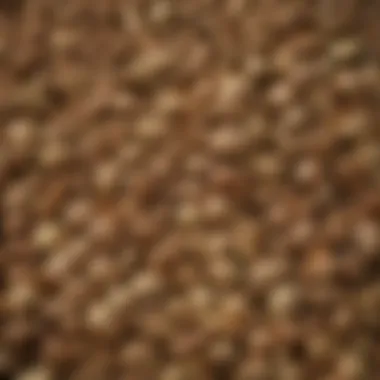Navigating the Ginseng Seed Market: Insights and Practices


Intro
The ginseng seed market serves as a fascinating intersection of ecological stewardship and economic opportunity. This article examines the nuances of ginseng seeds within the broader framework of woodland ecosystems. Ginseng, particularly valued for its medicinal properties, has garnered attention from both forest management practitioners and individuals seeking sustainable agricultural ventures. Understanding the significance of ginseng seeds requires diving into topics such as sustainable forestry practices, woodland stewardship, and the economic implications surrounding ginseng cultivation.
Exploring these aspects helps stakeholders make informed decisions, reflecting on their role in conserving biodiversity and promoting sustainable environments. This guide aims to provide a comprehensive overview of ginseng seeds, offering insights that will be valuable to forestry professionals, academics, and enthusiasts alike.
Prelude to Ginseng Cultivation
Ginseng cultivation encompasses various practices and considerations crucial for those looking to harness the economic potential of this valuable herb. Ginseng is not just a group of plants; it represents a profound tradition in herbal medicine and wellness. Understanding how to cultivate ginseng properly benefits not only individual growers but also contributes to sustainable agricultural practices. This discussion addresses the importance of cultivation methods, variety selection, and ecological factors that affect ginseng growth.
Historical Significance of Ginseng
Ginseng has a rich history that stretches back thousands of years. Originating in East Asia and North America, it has been valued in traditional medicine for its health-related properties. Cultures have long recognized ginseng's role in promoting vitality and longevity. For instance, in Chinese medicine, ginseng is considered a powerful adaptogen, helping the body adapt to stress and exert various health benefits. Its significance in ancient trade routes highlights its economic importance, illustrating how it has influenced commerce through history.
Wild ginseng, due to its rarity, holds higher economic value than cultivated types. This aspect has led to illegal harvesting practices, putting pressure on wild populations. Thus, knowing the historical significance underscores why ethical and sustainable cultivation methods are essential for preserving this valuable species and supporting local economies.
Overview of Ginseng Varieties
Ginseng comes in various forms, each with distinct characteristics and benefits. The two primary varieties are Asian ginseng, or Panax ginseng, and American ginseng, or Panax quinquefolius. Asian ginseng is noted for its stimulating properties, making it popular in traditional Chinese medicine. In contrast, American ginseng is often used for its calming effects, making it suitable for those seeking relaxation.
Other notable varieties include Korean red ginseng and Siberian ginseng, each offering unique compounds that contribute to their medicinal values. These variations present opportunities for growers to tailor their cultivation practices according to market demand.
Choosing the right variety is an essential step in ginseng cultivation. Sowing the seeds of a specific type can influence growth conditions, pest management practices, and even market appeal. Enthusiasts should consider local climate and soil conditions as well as consumer preferences when selecting ginseng seeds to cultivate.
Ginseng Seeds: Types and Sources
Understanding the types and sources of ginseng seeds is vital in optimizing cultivation outcomes. Not only do different types of seeds impact growth rates and yield, but they also influence the adaptability of ginseng to specific soil and climate conditions. Such information will aid foresters and cultivators to make informed choices when it comes to sourcing seeds, which is crucial in maintaining the quality and health of ginseng plants. This section discusses the two main categories of ginseng seeds: wild and cultivated.
Wild Ginseng Seeds
Wild ginseng seeds are sourced from naturally occurring plants. They are typically viewed as superior in terms of genetic diversity and adaptability. The ecological dynamics in which wild ginseng grows contribute to their robust growth patterns. The seeds carry traits suited for survival in varied conditions. However, collecting these seeds must align with legal regulations to protect wild populations. Harvesting should only be conducted in areas where the growth of wild ginseng is sustainable, preventing any risk of depletion.
Key benefits of wild ginseng seeds include:
- Genetic Diversity: Wild seeds often provide a broader genetic makeup, which can lead to improved resilience against pests and diseases.
- Higher Market Value: Due to their rarity and natural sourcing, wild ginseng seeds can attract higher prices, appealing to both cultivators and retailers who wish to reach high-end markets.
- Eco-Friendly Cultivation: Using wild seeds can sometimes be more environmentally sustainable, emphasizing a commitment to biodiversity.
Caution is necessary, as wild ginseng is often subject to strict regulations. Permits may be required for collecting seeds, and these can vary significantly by region. Understanding local laws is essential for anyone interested in sourcing wild ginseng seeds, ensuring compliance while also contributing to conservation efforts.
Cultivated Ginseng Seeds
Cultivated ginseng seeds come from plants that are grown in controlled environments, primarily for commercial purposes. These seeds often provide more uniformity in growth and yield when compared to wild seeds. Cultivated ginseng varieties are usually bred for specific traits such as higher medicinal compound content or faster growth, making them appealing for both farmers and consumers.
Several aspects underscore the importance of cultivated seeds:
- Consistent Quality: As cultivated ginseng is grown under regulated conditions, producers can often ensure higher and more reliable quality in each harvest.
- Adaptation to Farming Practices: These seeds are typically selected for their compatibility with modern agricultural methods, such as organic or conventional farming practices.
- Ease of Sourcing: Cultivated seeds can be more readily available through specialized suppliers, making it simpler for first-time growers to acquire what they need.
Furthermore, cultivated seeds enable farmers to tailor their growing conditions based on market demand, enhancing economic viability. Their cultivation management is less regulated than wild ginseng, allowing growers flexibility in methods used.
In contrast to wild seeds, cultivated ones can often lead to concerns about reduced genetic variability. This can make ginseng plants more vulnerable to diseases and environmental changes. As such, cultivators need to balance the benefits of consistency against the risks posed by monoculture practices.
Legal Considerations in Ginseng Cultivation


The legal environment surrounding ginseng cultivation is complex and varies by region. Understanding the laws and regulations becomes crucial for anyone considering ginseng farming. Compliance with legal standards not only safeguards the growers but also sustains the ginseng industry as a whole. This section aims to clarify the relevant legal aspects, ensuring that both novice and experienced growers are well-informed.
Regulations on Harvesting
Ginseng harvesting is governed by strict regulations. These laws are in place to protect natural populations and to prevent overharvesting. In many areas, wild ginseng harvesters are required to obtain permits before collecting plants. Moreover, certain states define specific harvesting seasons to allow ginseng to reproduce effectively.
In addition to seasonal restrictions, some regulations specify the minimum age of ginseng plants that can be harvested. Typically, only plants that are at least five years old can be collected. This approach encourages sustainable practices and ensures the longevity of ginseng populations in the wild. Compliance failures can result in severe penalties, including fines.
Permits for Ginseng Cultivation
Before starting a ginseng farming venture, growers must often obtain permits. Ginseng farming permits vary significantly from one jurisdiction to another. For instance, some states require comprehensive applications outlining cultivation plans. This may include details such as seed sources, planting methods, and anticipated harvest timelines.
Additionally, certain regions may impose zoning laws. These laws can restrict where ginseng can be cultivated based on land type or ecological restrictions. Farmers must be diligent in completing all necessary paperwork to avoid issues later on. Obtaining the right permits not only legalizes the cultivation process but also enhances the legitimacy of the farming operation. Failure to secure the correct permits can result in the shutdown of operations, fines, or even criminal charges.
It is crucial to follow local regulations and guidelines to ensure sustainable and legal ginseng cultivation.
Understanding legal considerations in ginseng cultivation offers several benefits. It helps protect the environment, promotes responsible farming practices, and supports the overall health of the ginseng market. Growers should stay updated on changes in laws and regulations to navigate the complexities of ginseng cultivation effectively.
Market Demand for Ginseng Seeds
Understanding the market demand for ginseng seeds is crucial for all involved in this sector. The demand encompasses various aspects such as consumer preferences, the availability of seeds, and market trends. Evaluating this demand can assist growers, suppliers, and stakeholders in making informed decisions that align with current industry movements. The relevance of this topic cannot be understated as the ginseng industry has significant economic implications, especially in regions where ginseng is cultivated extensively.
Trends in Ginseng Consumption
Recent years have shown a notable increase in ginseng consumption. Various factors contribute to this change. First, the rise in health consciousness among consumers has shifted them towards natural supplements. Ginseng is recognized for its health benefits, including boosting energy and enhancing cognitive function.
Moreover, cultural factors also influence ginseng's consumption. In Asian cultures, ginseng has been utilized for centuries and is considered a key element in traditional medicine. The growing interest in such medicinal plants has proliferated across Western markets, highlighting a fascinating fusion of traditions.
In addition, the increase in alternative health practices has led to broader acceptance and demand for ginseng. Consumers are willing to invest in high-quality products as they seek reliable sources of health enhancement. It's essential for sellers to remain vigilant about these consumption trends, as they directly impact seed sales and pricing.
Factors Influencing Market Prices
Market prices for ginseng seeds are shaped by several elements that stakeholders must consider. One significant factor is the availability of high-quality seeds. Quality influences not only price but also consumer preferences. Seeds that are well-documented and have demonstrated successful growth patterns are often priced higher due to their perceived value.
Another influencing aspect is the geographic origin of ginseng. Wild ginseng, often Scarce and highly valued, commands a much higher price compared to cultivated varieties. The rarity of wild ginseng, coupled with legal protections in various regions, creates a unique market dynamic.
Moreover, fluctuations in consumer demand also play a role. If a health trend emerges, it can spike demand and consequently prices. Seasonal changes in harvesting also impact pricing, as does the overall economic landscape affecting consumer purchasing power.
In summary, a comprehensive understanding of market demand for ginseng seeds is vital for informed decisions in cultivation and sales strategies. As both trends in consumption and factors influencing prices continue to evolve, keeping abreast of these changes is essential for success in the ginseng industry.
Purchasing Ginseng Seeds
Understanding the process of purchasing ginseng seeds is crucial for anyone interested in ginseng cultivation. It involves not only the transaction itself but also various factors that influence the quality and suitability of the seeds. In this section, we will discuss the best practices for acquiring ginseng seeds, where to find them, and how to assess their quality.
Where to Buy Ginseng Seeds
When looking to buy ginseng seeds, it's essential to locate reliable sources. The primary options include:
- Specialty Nurseries: Many nurseries specialize in medicinal herbs, including ginseng. They often carry both wild and cultivated seeds, and their staff can provide valuable insights into ginseng cultivation.
- Online Retailers: Websites like Burpee or Richters offer a range of ginseng seeds. Ensure these platforms are reputable to avoid low-quality seeds.
- Seed Exchanges: Community forums or gardening clubs sometimes have seed exchanges where you can acquire various seeds, including ginseng. Engaging with knowledgeable individuals has the added benefit of getting firsthand cultivation advice.
- Local Farmers’ Markets: Some local markets sell seeds directly from farmers. This can also offer a chance to learn about the seeds' origin and farming methods.
It is prudent to verify the credibility of any seller. Look for reviews and possibly get recommendations from fellow cultivators.
Evaluating Seed Quality


After locating potential sources, assessing the quality of ginseng seeds is a vital next step. Not all ginseng seeds are created equal, and poor-quality seeds can lead to low germination rates and unhealthy plants. Here are critical factors to consider:
- Germination Rate: Good quality ginseng seeds should have a high germination rate. Ask the seller if this information is available. A rate of 80% or higher is generally acceptable.
- Seed Appearance: Inspect the seeds. Healthy ginseng seeds are typically plump and firm. Avoid shriveled or discolored seeds, as they may indicate poor viability.
- Freshness: Ginseng seeds lose viability over time. It is recommended to purchase seeds harvested within the last year for the best results. Check for production or harvest dates when possible.
- Certification: Some sellers may provide certification for the seeds, especially if they are organic or wild-sourced. This can give confidence in their quality and ethical sourcing.
Investment in quality seeds is an important decision for successful ginseng cultivation.
Cultivation Practices for Ginseng
Cultivation practices play a vital role in the successful growing of ginseng. Ginseng is a delicate plant that requires specific conditions to reach its full potential. The methods opted for cultivating ginseng can significantly impact both the quality of the product and the sustainability of the farming practice. Attention to details in cultivation leads to healthier plants, better yields, and ultimately, a more profitable endeavor.
Ideal Growing Conditions
Ginseng thrives in particular environmental conditions, which makes understanding its requirements critical for successful cultivation. Ideal growing conditions include:
- Shade: Ginseng naturally grows in the understory of forests. It requires approximately 75% to 90% shade, which mimics its natural habitat. Too much direct sunlight may harm the plants, thus affecting their growth.
- Soil Type: The right soil is crucial. Sandy loam or well-drained forest soils rich in organic matter provide an optimal environment. The soil's pH should remain between 5.5 and 6.5 to support nutrient uptake.
- Moisture: Consistent moisture is important, but over-watered conditions can be detrimental. Adequate drainage allows plants to receive sufficient water without being waterlogged.
- Temperature: Ginseng typically grows best in areas with temperate climates. A temperature range between 60°F and 70°F is ideal.
Maintaining these conditions not only promotes the healthy growth of ginseng but also enhances its medicinal properties.
Organic vs Conventional Methods
The choice between organic and conventional methods is a significant decision for ginseng cultivators. Each method comes with its advantages and challenges.
Organic Methods
- Focus on sustainable practices that avoid synthetic chemicals. Natural fertilizers, such as compost, can enrich the soil.
- Pest control strategies usually involve biological methods, like introducing beneficial insects or using neem oil.
- Organic ginseng often fetches a higher price in the market, as consumers are increasingly aware and supportive of sustainably farmed products.
Conventional Methods
- Often, these methods can yield faster results through the use of synthetic fertilizers and pesticides. This can be appealing to those looking to maximize short-term profits.
- However, over-reliance on chemicals can lead to soil degradation and long-term environmental concerns.
- Conventional ginseng may have lower market prices compared to its organic counterpart, affecting overall profitability.
Choosing between these cultivation approaches requires careful consideration of the long-term implications and the values of the growers.
"The method of cultivation directly influences not just the yield but the quality and marketability of ginseng."
By understanding the specifics of growing conditions and selecting appropriate cultivation techniques, cultivators can enhance their ginseng production while aligning with market demands and environmental responsibilities.
Pest and Disease Management
Effective pest and disease management is paramount in ginseng cultivation. Addressing these issues not only preserves plant health but also maximizes yield and profitability. Ginseng, being a high-value crop, requires careful monitoring and proactive measures to mitigate risks associated with pests and diseases. Understanding how to manage these threats can lead to better quality roots and sustainable farming practices.
Common Pests Affecting Ginseng
Pests can severely impact ginseng plants, affecting their growth and overall quality. Some of the most common pests include:
- Kudzu Bugs: These small green or brown bugs feed on ginseng leaves, leading to stunted growth.
- Spider Mites: They thrive in warm conditions and can cause leaf discoloration and drop.
- Root Maggots: These pests damage the root system, which is critical to ginseng's market value.
- Leafhoppers: They transmit diseases and also feed on plant sap, weakening the plants.
Identifying these pests early is crucial. Regular monitoring and scouting can help in spotting infestations before they escalate.
Preventative Measures
Preventing pest infestations and managing diseases effectively involves a combination of practices. Here are some important measures to consider:
- Crop Rotation: Changing the planting location can disrupt pest life cycles.
- Companion Planting: Certain plants can deter pests naturally. For example, planting garlic or marigolds can help keep unwanted insects away.
- Soil Health Management: Healthy soils contribute to strong plants. Regular soil testing can guide fertilization and amendment practices to ensure optimal plant health.
- Regular Monitoring: Employ a schedule for inspecting ginseng plants. Look for signs of infestations or disease early.
- Biological Control: Introduce natural predators of pests, such as ladybugs, to help keep pest populations in check.


Implementing these strategies forms the foundation of a robust pest management plan for ginseng. By being proactive and informed, cultivators can shield their crops from the numerous threats posed by pests and diseases.
Ecological Impact of Ginseng Cultivation
Ginseng cultivation poses significant ecological considerations that warrant careful examination. This section sheds light on the relationship between ginseng farming practices and their broader environmental implications. Addressing the ecological impact is crucial, as stakeholders must consider both the benefits and potential drawbacks of ginseng cultivation. It influences not just sustainable practices but also informs decision-making regarding land use and resource management in forestry sectors.
Biodiversity Considerations
The cultivation of ginseng can have a noteworthy effect on local biodiversity. Traditionally, ginseng grows in the wild, embedded within diverse forest ecosystems. Its cultivation often shifts these ecosystems, introducing new challenges.
When establishing ginseng farms, it is essential to maintain the surrounding native flora and fauna to ensure ecological balance. One way to support biodiversity is by promoting companion planting. This approach allows for the integration of various species, which can improve pest control and enhance soil health. Fostered biodiversity can also help the ginseng plants themselves. A rich ecosystem can attract beneficial insects and other organisms that contribute to pollination and disease resistance.
Management strategies, such as observing crop rotation and preserving native plant species, can bolster biodiversity. Implementing such strategies ensures not only the health of the ginseng crop but also the longevity of the ecosystem.
Soil Health and Ginseng
Soil health is a fundamental aspect of ginseng cultivation, influencing both crop yield and ecological sustainability. Healthy soil fosters plant growth, enhances nutrient availability, and improves water retention. In contrast, practices such as monoculture or excessive pesticide use can degrade soil quality over time.
Ginseng thrives in well-draining, loamy soils rich in organic matter. Thus, maintaining soil health becomes vital not only for the success of the ginseng crop but also for the surrounding flora. Regular testing can guide amendments and fertilizers ensuring proper pH and nutrient levels.
Incorporating organic materials such as compost or using cover crops can revitalize soil structure. Such practices contribute positively to soil microbiomes, essential for nutrient cycling. Keeping soil healthy promotes resilience against pests and diseases, creating a harmonious relationship between cultivation and ecology.
"Achieving a balance in soil health and biodiversity is essential for the sustainable cultivation of ginseng. Doing so supports the ecosystem while ensuring productivity."
By prioritizing biodiversity and soil health in ginseng cultivation, farmers not only contribute to the environment but also enhance their own economic stability. These elements underscore the importance of thoughtful practices to maintain ecological integrity.
The Future of Ginseng Cultivation
The future of ginseng cultivation stands at a crossroads of tradition and innovation. As the global market for herbal medicine grows, the demand for high-quality ginseng is on the rise. This trend is driven by both the health benefits associated with ginseng and the increasing interest in natural remedies. While wild ginseng has historical significance, cultivated ginseng is becoming a viable alternative due to conservation concerns over wild populations. The forward-looking practices in ginseng farming directly impact not just the economy but also the ecosystem where cultivation occurs. Understanding these trends is crucial for stakeholders in the forestry sector and aspiring farmers.
Innovations in Ginseng Farming
Recent advances in agronomic technology are shaping the future of ginseng cultivation. For instance, researchers are exploring genetic improvements. This includes selective breeding to enhance disease resistance and yield. Innovations in planting techniques, such as the use of biodegradable seed coverings, offer potential ecological benefits by reducing plastic waste.
Additionally, the integration of precision agriculture techniques is gaining traction. These methods involve using sensors and data analytics to monitor soil health and moisture levels. By closely managing these factors, farmers can optimize growth conditions. Implementation of these technologies creates an efficient farming system, minimizing resource waste while maximizing output.
"Innovative farming techniques are transforming how we approach ginseng cultivation, blending technology with age-old practices."
Sustainability Practices
Sustainable practices are becoming essential in ginseng cultivation. These practices are vital for preserving the land and maintaining a viable ginseng market. Farmers are increasingly adopting crop rotations to improve soil health and reduce pest populations. Utilizing organic fertilizers and compost enhances soil fertility without harmful chemicals.
Water management also plays a key role. Efficient irrigation systems ensure that water is conserved, promoting healthier plants while reducing environmental impact. Here are some sustainability practices gaining popularity:
- Agroforestry: Integrating ginseng cultivation with tree cover helps maintain biodiversity.
- Cover Cropping: Growing cover crops protects soil from erosion and enhances nutrient content.
- Integrated Pest Management: This approach uses natural predators and minimal external inputs to control pests, reducing reliance on chemical pesticides.
With effective and responsible stewardship, future ginseng cultivation can thrive while supporting ecological balance. Both innovation and sustainability are not merely trends but necessary shifts for long-term success.
Ending
In examining the multifaceted topic of ginseng seeds, several crucial elements emerge that underline their significance within both the market and ecological contexts. Understanding ginseng seeds is pivotal for fostering sustainable ginseng cultivation and for ensuring that economic viability aligns with ecological stewardship. The benefits of this knowledge extend beyond mere financial gain; it offers insights into cultivation practices that maintain soil health and promote biodiversity.
Recap of Key Points
- Types of Ginseng Seeds: Distinguishing between wild and cultivated ginseng seeds is vital. Each type presents unique traits and influences market dynamics.
- Market Demand: The increasing interest in ginseng products has driven demand for high-quality seeds, correlated to trends in consumer preferences and health consciousness.
- Legal Regulations: Adhering to regulations regarding harvesting and cultivation permits ensures responsible practices in the ginseng market.
- Cultivation Practices: Best practices in ginseng farming address ideal growing conditions and the choice between organic and conventional methods, influencing both yield and quality of seeds.
- Sustainability Initiatives: Incorporating innovations and sustainability throughout cultivation practices supports ecological health and meets market demands effectively.
Final Thoughts on Ginseng Seeds
As the interest in ginseng continues to rise, understanding the comprehensive market for ginseng seeds remains indispensable. Stakeholders must approach this opportunity with careful consideration of both economic benefits and environmental responsibilities. The cultivation of ginseng not only provides potential financial rewards but also plays a critical role in woodland stewardship. Ultimately, practicing responsible ginseng cultivation can foster a sustainable future for both the environment and the market.







